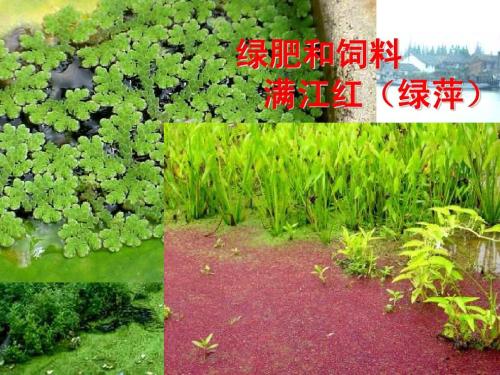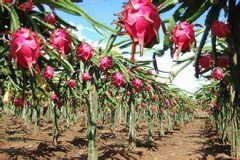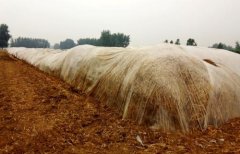Why does Manjianghong serve as green manure? Is Manjianghong an excellent green manure and feed?
Application of Manjiang Red and Green Fertilizer in Paddy Field farming: Manjianghong we have always been regarded as aquatic pollution plants, but in fact, it is good, if you do not know, then take a look at this. It is of great use in paddy fields.
To reduce the production cost of food crops, reduce the application of chemical fertilizers and avoid environmental pollution, maintain soil fertility and sustainable land use, planting green manure is the best of both worlds. However, the paddy field can not carry out the general dry cultivation of green manure, so the aquatic plant-Manjianghong has become the best paddy field crop for green manure, and does not take up space, so it is easy to cultivate.

Taxonomic status, Morphology and growth habits of Manjianghong
Azolla is a perennial aquatic pteridophyte floating on the surface of the water. Manjianghong (Manjianghong) is the only genus in the world. There are six species in the genus, namely, A.caroliniana, A.filiculoides, A.mexicana, A.microphylla, A. nilotica and A.pinnata, and there is one species of A.pinnata in Taiwan. Manjianghong can be seen in paddy fields, ponds, swamps and other waters, mainly growing in the subtropics and tropics. The plant size and shape vary from strain to strain.
There are A.pinnata species in Taiwan, with triangular plants, no more than 1cm wide and leaves up to 0.1cm long. The stem bears roots and leaves, and the leaves are arranged in a pinnate shape, each leaf is divided into upper and lower leaves, the upper lobe floats on the surface, there are assimilation tissue and stomata, and the inside is filled with many mucous cavities, in which there is a symbiosis of moniliform nitrogen-fixing blue-green algae Anabaena azollae, and the lower lobe is membranous and submerged. Usually the main line of asexual reproduction, when the weather is cold or too hot will produce male and female spores and carry out sexual reproduction. In the low temperature in autumn and winter, the chlorophyll of the plant is destroyed and red anthocyanin (red anthocyanin pigment) is produced, which makes the water area of its distribution show a red landscape, so it is called Manjianghong.
Environmental factors affecting the growth of Manjianghong
A. pinnata variety Manjianghong is the most suitable to grow in the environment of PH 4.5-7.0,15-30 degrees Celsius and light intensity 12000 Lux. It propagates rapidly and grows strongly. Its fresh weight can increase to 16 times after about 15 days after stocking and inoculation, and can continue to multiply in the way of lamination, reaching about 4-5 layers.
Manjianghong can grow in the environment without nitrogen source. Due to the strong nitrogen-fixing ability of blue-green algae Anabaena azollae in the leaves, the plant can provide nitrogen and reduce the use of chemical nitrogen fertilizer after being applied to the field soil decomposition. The most important nutrient for the growth of Manjianghong is phosphate fertilizer, followed by iron. When lack of phosphate fertilizer, the growth of Manjianghong was very poor, the plant turned yellow and the nitrogen content decreased. In addition, in some soils with high calcareous content and PH value, and low environmental iron content and availability, Manjianghong had poor reproduction and nitrogen fixation ability, and the plant turned yellow. Excessive nitrogen fertilizer will be disadvantageous to the growth of Manjianghong, reduce the nitrogen fixation ability of blue-green algae, and promote the growth of other weeds, which is disadvantageous to the control of weeds in paddy field. If the amount of nitrogen is less than 18 kg per hectare at the initial stage of stocking Manjianghong, combined with the application of phosphoric anhydride 20-40 kg per hectare, it not only does not affect the nitrogen fixation of Manjianghong, but also helps to increase the fresh weight.
The summer climate sunshine is strong, the air temperature is high, the water temperature is often 42 degrees Celsius, prone to heat damage and insect pests. When the water temperature was too high and the sunshine was too strong, the color of red leaves changed from thick green to yellowish brown, the growth rate was slow, and the inhibition effect on weed mulching decreased. Therefore, at the initial stage of transplanting rice seedlings in the second stage, Manjianghong grew slowly. When the tillers of rice plants were more exuberant, the leaves of rice shaded each other, and the growth of Manjianghong under the leaves began to flourish rapidly. The breeding rate in the second month is about six times faster than that in the first month. Although the growth of Manjianghong in the first-stage rice field occasionally encountered a period of low temperature, its growth was still thick green, so the local species did not have to worry about low temperature. Water depth will also affect the growth of Manjianghong, insufficient water depth can not make Manjianghong float, and its reproduction rate will slow down.
Field Application, Fertilizer effect and Weed inhibition effect of Manjianghong
There are many mucous cavities on the inside of Manjiang red leaves, which contain symbiotic nitrogen-fixing blue-green algae, so they have strong ability of nitrogen fixation and can supply a large amount of nitrogen after ploughing into the soil, which can reduce the application amount of chemical nitrogen fertilizer and save cost. it is an excellent green manure in paddy field and does not take up space. Easy cultivation.
Under suitable light and temperature, it grows very rapidly, doubles in about four days, and has a strong coverage. It has a strong effect on the inhibition of weeds in paddy fields, almost on most of the weeds in paddy fields. Its weed control effect is similar to the application of "immediate weeding" herbicides, which can reduce the application of herbicides. The stocking of Magnolia mandshurica in the water release field or lotus field at the initial stage of water release can also inhibit the growth of weeds and sedge algae, but the application amount of water chestnut field should be more than that of rice field, because the water chestnut field has no shelter and the sun is strong at high temperature in summer. Manjianghong is easy to turn yellowish brown and reduce the reproduction rate. If there is no more manjianghong stocking at the initial stage, the effect on water surface coverage is poor, and the inhibitory effect on Chaetophyllum will be less significant.
Rice can be propagated in a small field before transplanting seedlings. Phosphate fertilizer is the most important fertilizer in Manjianghong. The appropriate amount of phosphoric anhydride is about 7.5-15 kg per hectare, but no nitrogen fertilizer can be added. After soil preparation and transplanting, the propagated Manjianghong can be released to the field, and the fresh weight per minute is about 25-30 in the field. The growth rate is slow at the initial stage of stocking, and the coverage rate is about 30% after 30 days. When the rice tillers began to flourish, the growth rate was about 90% in 50 days.
The fresh weight of Manjianghong is about 15000 kg per hectare. After ploughing into the soil, it can supply 38 kg of nitrogen, 8 kg of phosphoric anhydride and 24 kg of potassium oxide. therefore, after ploughing into the soil, its fertilizer effect will be slowly decomposed and released, and its organic matter content is 50%, which can increase the soil organic matter content.
Now you know that Manjianghong has this advantage. Therefore, it is necessary to look at things in two ways, and it is the same to look at plants.
- Prev

Planting dragon fruit technology: what are the dragon fruit planting techniques and techniques?
If we want to grow dragon fruit, we first need to understand its characteristics and growing environment. As the root system of Honglongguo is shallow and flat on the surface, the supplement of soil organic matter should fully apply organic matter fertilizer with low nitrogen and crude matter at the time of garden preparation, so as to raise the surface by 20 cm.
- Next

Homemade organic fertilizer: what is compost? What are the benefits of composting?
Organic composting, composting is an ancient technology, do not need accurate calculation and advanced skills, as long as you pay attention, can not only solve the problem of waste environmental protection, but also improve soil productivity, it is worth adopting. Now let's take a look at it together. Farm pile
Related
- Fuxing push coffee new agricultural production and marketing class: lack of small-scale processing plants
- Jujube rice field leisure farm deep ploughing Yilan for five years to create a space for organic food and play
- Nongyu Farm-A trial of organic papaya for brave women with advanced technology
- Four points for attention in the prevention and control of diseases and insect pests of edible fungi
- How to add nutrient solution to Edible Fungi
- Is there any good way to control edible fungus mites?
- Open Inoculation Technology of Edible Fungi
- Is there any clever way to use fertilizer for edible fungus in winter?
- What agents are used to kill the pathogens of edible fungi in the mushroom shed?
- Rapid drying of Edible Fungi

